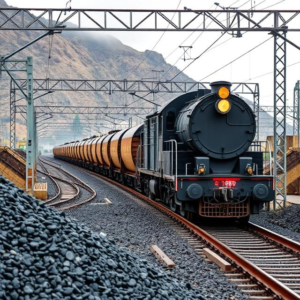Coal transport by Indian Railways is a crucial part of how India moves coal from mines to power plants, industries, and other places that need it. Coal is one of the main sources of energy in India, and Indian Railways plays a major role in making sure it reaches the right destinations efficiently. Here’s an easy explanation of how it works:

1. Why is Coal Important for India?
- Energy Source: Coal is used to generate electricity in power plants, so it’s essential for India’s energy needs.
- Industry Use: Coal is also used in industries like cement, steel, and chemical production.
Because coal is so important, transporting it from mines (where it’s extracted) to the places it’s needed is a big task.
2. Role of Indian Railways in Coal Transport
Indian Railways is one of the largest transport systems in the world, and it handles a huge amount of coal transportation. Trains are the best way to move large quantities of coal over long distances because they can carry a lot of weight at a relatively low cost.
3. How Does Coal Transport by Rail Work?
- From the Mines: Coal is extracted from coal mines, which are spread across India. Some of the major coal-producing states are Jharkhand, Odisha, Chhattisgarh, Madhya Pradesh, and West Bengal.
- Loading the Coal: The coal is loaded into large wagons, called coal rakes or open wagons, that are specially designed to carry coal. These trains are long and can carry thousands of tons of coal at once.
- Transportation: Once the coal is loaded, it is transported by trains to various destinations, such as power plants, factories, and ports. Coal can travel hundreds of kilometers by rail. Special dedicated freight corridors are being built to speed up coal transportation.
- Unloading: When the coal reaches its destination, it is unloaded from the train at special coal handling terminals or directly at power plants or industrial units.
4. Benefits of Rail Transport for Coal
- Cost-Effective: Rail transport is cheaper for moving heavy and bulky goods like coal over long distances. Roads would be much more expensive and less efficient.
- Large Quantities: Trains can carry a large amount of coal at once, meaning fewer trips are needed to transport the same amount compared to trucks.
- Reliability: Railways have a fixed schedule, which means coal can be delivered on time, unlike road transport, which might be affected by traffic or weather conditions.
- Environmental Impact: While trains still use fuel, rail transport can be more environmentally friendly compared to road transport, especially when carrying heavy loads like coal.
5. Challenges in Coal Transport by Rail
- Congestion: Railways can get congested, especially during peak times when there’s a lot of coal to move, which can delay deliveries.
- Maintenance: Some railway tracks, stations, and terminals may not be modern enough to handle huge amounts of coal, requiring constant maintenance and upgrades.
- Demand-Supply Mismatch: Sometimes, the supply of coal doesn’t match the demand for it in power plants and industries, leading to shortages or delays.
6. Recent Improvements and Developments
- Dedicated Freight Corridors (DFCs): Indian Railways is building special railway tracks just for freight (including coal). These dedicated tracks will make coal transport faster and more efficient, reducing delays and congestion.
- High-Capacity Wagons: Newer, larger wagons are being introduced to carry more coal in one trip, making the process more efficient.
- Automation and Technology: Indian Railways is introducing digital systems for better scheduling and tracking of coal trains, which helps improve efficiency and reduces delays.
- Private Sector Involvement: In some cases, private companies are partnering with Indian Railways to improve coal transportation by bringing in new technologies, better management, and improved logistics.
7. The Big Picture
Coal transport by Indian Railways is essential for keeping the country’s power plants running and industries operating. The railway system is critical for moving coal quickly, cost-effectively, and in large quantities, helping India meet its energy and industrial needs.
Conclusion
In simple terms, Indian Railways is the backbone for transporting coal across India. It helps ensure that coal reaches power plants and industries on time, at a low cost, and in large amounts. Despite challenges, continuous improvements in infrastructure and technology are making coal transport more efficient, which is good for the country’s energy production and economic growth.
Keywords: Indian Railway, Railway










